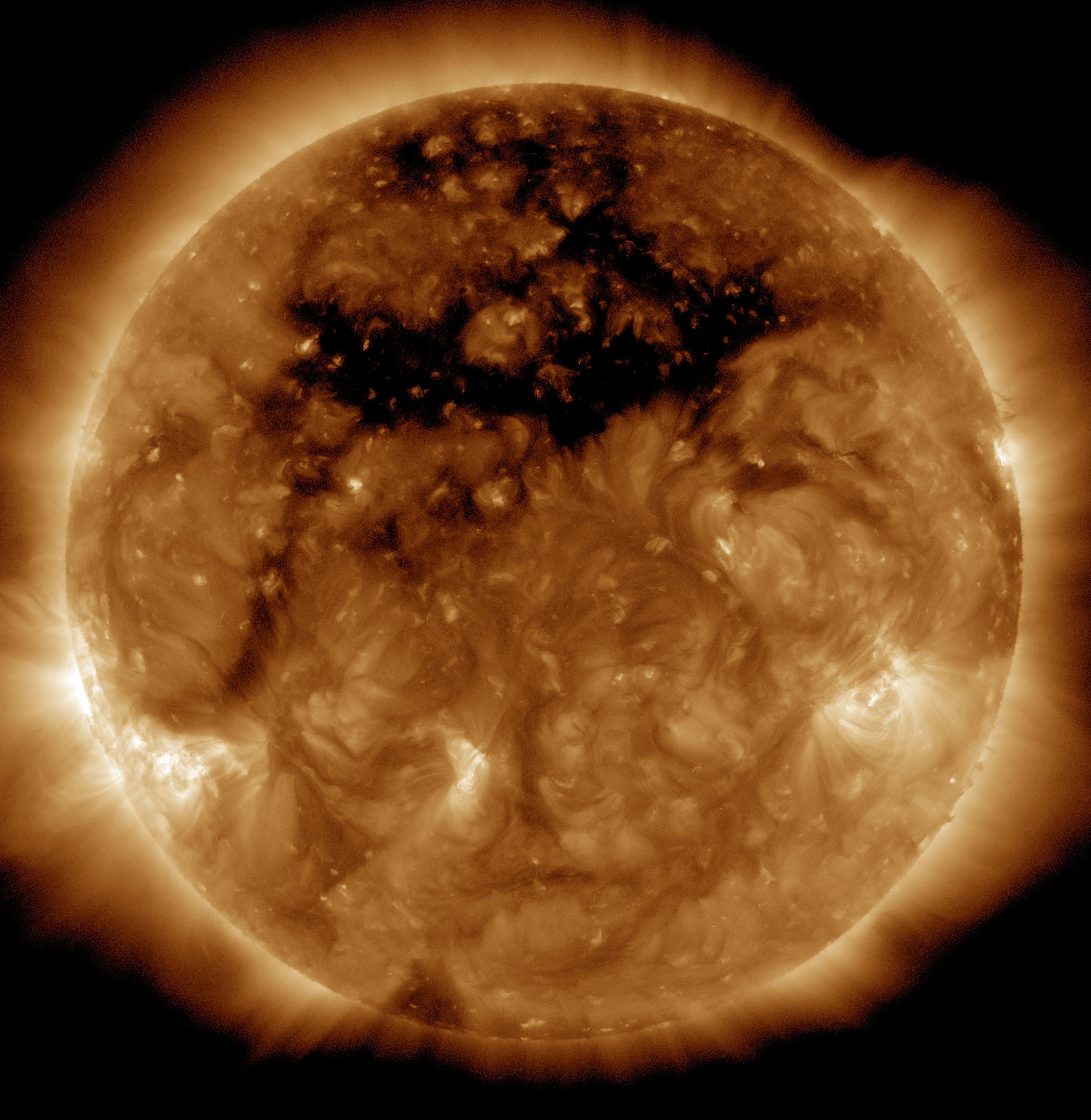 |
Solar Transition Region
The solar transition region is a region of the Sun's atmosphere between the upper chromosphere and corona. It is important because it is the site of several unrelated but important transitions in the physics of the solar atmosphere: * Below, gravity tends to dominate the shape of most features, so that the Sun may often be described in terms of layers and horizontal features (like sunspots); above, dynamic forces dominate the shape of most features, so that the transition region itself is not a well-defined layer at a particular altitude. * Below, most of the helium is not fully ionized, so that it radiates energy very effectively; above, it becomes fully ionized. This has a profound effect on the equilibrium temperature (see below). * Below, the material is opaque to the particular colors associated with spectral lines, so that most spectral lines formed below the transition region are absorption lines in infrared, visible light, and near ultraviolet, while most lines formed ... [...More Info...] [...Related Items...] OR: [Wikipedia] [Google] [Baidu] [Amazon] |
 |
Magnetohydrodynamics
In physics and engineering, magnetohydrodynamics (MHD; also called magneto-fluid dynamics or hydromagnetics) is a model of electrically conducting fluids that treats all interpenetrating particle species together as a single Continuum mechanics, continuous medium. It is primarily concerned with the low-frequency, large-scale, magnetic behavior in Plasma (physics), plasmas and liquid metals and has applications in multiple fields including space physics, geophysics, astrophysics, and engineering. The word ''magnetohydrodynamics'' is derived from ' meaning magnetic field, ' meaning water, and ' meaning movement. The field of MHD was initiated by Hannes Alfvén, for which he received the Nobel Prize in Physics in 1970. History The MHD description of electrically conducting fluids was first developed by Hannes Alfvén in a 1942 paper published in Nature (journal), ''Nature'' titled "Existence of Electromagnetic–Hydrodynamic Waves" which outlined his discovery ... [...More Info...] [...Related Items...] OR: [Wikipedia] [Google] [Baidu] [Amazon] |
 |
Solar Spicule
In solar physics, a spicule, also known as a fibril or mottle, is a dynamic jet of plasma in the Sun's chromosphere about 300 km in diameter.Quantifying Spicules, Tiago M. D. Pereira, Bart De Pontieu, and Mats Carlsson, ''The Astrophysical Journal'' 759, #1 (October 2012), pp. 18-34, , . They move upwards with speeds between 15 and 110 km/s from the photosphere and last a few minutes each before falling back to the solar atmosphere. They were discovered in 1877 by Angelo Secchi, but the physical mechanism that generates them is still hotly debated. Description Spicules last for about 15 minutes; at the solar limb they appear elongated (if seen on the disk, they are known as "mottles" or "fibrils"). They are usually associated with regions of high magnetic flux; their mass flux is about 100 times that of the solar wind. They rise at a rate of 20 km/s (or 72,000 km/h) and can reach several thousand kilometers in height before collapsing and fading away. P ... [...More Info...] [...Related Items...] OR: [Wikipedia] [Google] [Baidu] [Amazon] |
 |
Coronal Hole
Coronal holes are regions of the Sun's corona that emit low levels of ultraviolet and X-ray radiation compared to their surroundings. They are composed of relatively cool and tenuous plasma (physics), plasma permeated by magnetic fields that are open to interplanetary space.Freedman, Roger A., and William J. Kaufmann III. "Our Star, the Sun." Universe. 8th ed. New York: W.H. Freeman, 2008. 419–420. Print. Compared to the corona's usual closed magnetic field that arches between regions of opposite magnetic polarity, the open magnetic field of a coronal hole allows solar wind to escape into space at a much quicker rate. This results in decreased temperature and density of the plasma at the site of a coronal hole, as well as an increased speed in the average solar wind measured in interplanetary space. Streams of fast solar wind originating from coronal holes can interact with slow solar wind streams to produce corotating interaction regions. These regions can interact with Earth's ... [...More Info...] [...Related Items...] OR: [Wikipedia] [Google] [Baidu] [Amazon] |
 |
Moreton Wave
A Moreton wave, Solar Tsunami, or Moreton-Ramsey wave is the chromospheric signature of a large-scale solar corona shock wave. Described as a kind of solar "tsunami", they are generated by solar flares. They are named for American astronomer Gail Moreton, an observer at the Lockheed Solar Observatory in Burbank, and Harry E. Ramsey, an observer who spotted them in 1959 at The Sacramento Peak Observatory. He discovered them in time-lapse photography of the chromosphere in the light of the Balmer alpha transition. There were few follow-up studies for decades. Then the 1995 launch of the Solar and Heliospheric Observatory (SOHO) led to observation of coronal waves, which cause Moreton waves. Moreton waves were a research topic again. (SOHO's EIT instrument discovered another, different wave type called "EIT waves".) The reality of Moreton waves (also known as fast-mode MHD waves) has also been confirmed by the two Solar Terrestrial Relations Observatory (STEREO) spacecraft. ... [...More Info...] [...Related Items...] OR: [Wikipedia] [Google] [Baidu] [Amazon] |
 |
Solar Physicist
Solar physics is the branch of astrophysics that specializes in the study of the Sun. It intersects with many disciplines of pure physics and astrophysics. Because the Sun is uniquely situated for close-range observing (other stars cannot be resolved with anything like the spatial or temporal resolution that the Sun can), there is a split between the related discipline of observational astrophysics (of distant stars) and observational solar physics. The study of solar physics is also important as it provides a "physical laboratory" for the study of plasma physics. History Ancient times Babylonians were keeping a record of solar eclipses, with the oldest record originating from the ancient city of Ugarit, in modern-day Syria. This record dates to about 1300 BC. Ancient Chinese astronomers were also observing solar phenomena (such as solar eclipses and visible sunspots) with the purpose of keeping track of calendars, which were based on lunar and solar cycles. Unfortunately, recor ... [...More Info...] [...Related Items...] OR: [Wikipedia] [Google] [Baidu] [Amazon] |
|
Phase Transition
In physics, chemistry, and other related fields like biology, a phase transition (or phase change) is the physical process of transition between one state of a medium and another. Commonly the term is used to refer to changes among the basic State of matter, states of matter: solid, liquid, and gas, and in rare cases, plasma (physics), plasma. A phase of a thermodynamic system and the states of matter have uniform physical property, physical properties. During a phase transition of a given medium, certain properties of the medium change as a result of the change of external conditions, such as temperature or pressure. This can be a discontinuous change; for example, a liquid may become gas upon heating to its boiling point, resulting in an abrupt change in volume. The identification of the external conditions at which a transformation occurs defines the phase transition point. Types of phase transition States of matter Phase transitions commonly refer to when a substance tran ... [...More Info...] [...Related Items...] OR: [Wikipedia] [Google] [Baidu] [Amazon] |
|
 |
Kelvin
The kelvin (symbol: K) is the base unit for temperature in the International System of Units (SI). The Kelvin scale is an absolute temperature scale that starts at the lowest possible temperature (absolute zero), taken to be 0 K. By definition, the Celsius scale (symbol °C) and the Kelvin scale have the exact same magnitude; that is, a rise of 1 K is equal to a rise of 1 °C and vice versa, and any temperature in degrees Celsius can be converted to kelvin by adding 273.15. The 19th century British scientist Lord Kelvin first developed and proposed the scale. It was often called the "absolute Celsius" scale in the early 20th century. The kelvin was formally added to the International System of Units in 1954, defining 273.16 K to be the triple point of water. The Celsius, Fahrenheit, and Rankine scales were redefined in terms of the Kelvin scale using this definition. The 2019 revision of the SI now defines the kelvin in terms of energy by setting the Bo ... [...More Info...] [...Related Items...] OR: [Wikipedia] [Google] [Baidu] [Amazon] |
|
Lyman Series
In physics and chemistry, the Lyman series is a hydrogen spectral series of transitions and resulting ultraviolet emission lines of the hydrogen atom as an electron goes from ''n'' ≥ 2 to ''n'' = 1 (where ''n'' is the principal quantum number), the lowest energy level of the electron (groundstate). The transitions are named sequentially by Greek letters: from ''n'' = 2 to ''n'' = 1 is called Lyman-alpha, 3 to 1 is Lyman-beta, 4 to 1 is Lyman-gamma, and so on. The series is named after its discoverer, Theodore Lyman. The greater the difference in the principal quantum numbers, the higher the energy of the electromagnetic emission. History The first line in the spectrum of the Lyman series was discovered in 1906 by physicist Theodore Lyman IV, who was studying the ultraviolet spectrum of electrically excited hydrogen gas. The rest of the lines of the spectrum (all in the ultraviolet) were discovered by Lyman from 1906-1914. The spectrum of ... [...More Info...] [...Related Items...] OR: [Wikipedia] [Google] [Baidu] [Amazon] |
|
|
Black-body Radiation
Black-body radiation is the thermal radiation, thermal electromagnetic radiation within, or surrounding, a body in thermodynamic equilibrium with its environment, emitted by a black body (an idealized opaque, non-reflective body). It has a specific continuous spectrum that depends only on the body's temperature., Chapter 13. A perfectly-insulated enclosure which is in thermal equilibrium internally contains blackbody radiation and will emit it through a hole made in its wall, provided the hole is small enough to have a negligible effect upon the equilibrium. The thermal radiation spontaneously emitted by many ordinary objects can be approximated as blackbody radiation. Of particular importance, although planets and stars (including the Earth and Sun) are neither in thermal equilibrium with their surroundings nor perfect black bodies, blackbody radiation is still a good first approximation for the energy they emit. The term ''black body'' was introduced by Gustav Kirchhoff in 1860. ... [...More Info...] [...Related Items...] OR: [Wikipedia] [Google] [Baidu] [Amazon] |
|
 |
Electron
The electron (, or in nuclear reactions) is a subatomic particle with a negative one elementary charge, elementary electric charge. It is a fundamental particle that comprises the ordinary matter that makes up the universe, along with up quark, up and down quark, down quarks. Electrons are extremely lightweight particles that orbit the positively charged atomic nucleus, nucleus of atoms. Their negative charge is balanced by the positive charge of protons in the nucleus, giving atoms their overall electric charge#Charge neutrality, neutral charge. Ordinary matter is composed of atoms, each consisting of a positively charged nucleus surrounded by a number of orbiting electrons equal to the number of protons. The configuration and energy levels of these orbiting electrons determine the chemical properties of an atom. Electrons are bound to the nucleus to different degrees. The outermost or valence electron, valence electrons are the least tightly bound and are responsible for th ... [...More Info...] [...Related Items...] OR: [Wikipedia] [Google] [Baidu] [Amazon] |
 |
Ionization
Ionization or ionisation is the process by which an atom or a molecule acquires a negative or positive Electric charge, charge by gaining or losing electrons, often in conjunction with other chemical changes. The resulting electrically charged atom or molecule is called an ion. Ionization can result from the loss of an electron after collisions with subatomic particles, collisions with other atoms, molecules, electrons, positrons, protons, antiprotons, and ions, or through the interaction with electromagnetic radiation. Heterolytic bond cleavage and heterolytic substitution reactions can result in the formation of ion pairs. Ionization can occur through radioactive decay by the internal conversion process, in which an excited nucleus transfers its energy to one of the inner-shell electrons causing it to be ejected. Uses Everyday examples of gas ionization occur within a fluorescent lamp or other electrical discharge lamps. It is also used in radiation detectors such as the Geiger- ... [...More Info...] [...Related Items...] OR: [Wikipedia] [Google] [Baidu] [Amazon] |